Donna Smallin Kuper's Blog: The One-Minute Organizer Blog, page 7
January 2, 2019
What I Learned in 2018 About Cleaning and Clutter
I always get excited when I learn something new. I figure if it’s something I never knew, especially something about cleaning or decluttering, then it might be something you never knew. And then I can’t wait to share it!
For example, my husband kept telling to run hot water in the kitchen sink for one minute prior to starting the dishwasher. Turns out he was right. Hot water is needed immediately to activate the detergent.
And did I ever tell you that you can you can remove food stains from plastic leftover containers by placing them in direct sunlight for a day or so? Or that a wet Brillo pad cleans soap scum and water spots from glass shower doors faster and easier than anything else I’ve tried? (And no, it won’t scratch the glass.)
In this blog post, I want to share a few things I learned in 2018 about cleaning and clutter.
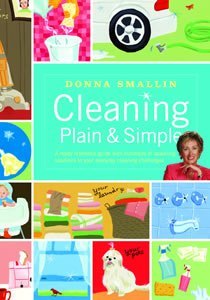 You may want to say “no” to kitchen sponges – here’s why.
You may want to say “no” to kitchen sponges – here’s why.Back when I was writing Cleaning Plain & Simple, I learned that the average kitchen sponge harbors as many as 7 billion germs. Yuck! My advice was to zap wet sponges in the microwave for two minutes to disinfect – and to do this every day. But new research has thrown that advice into question. According to this study:
Microwave and boiling treatments were shown to significantly reduce the bacterial load [but] no method alone seemed to be able to achieve a general bacterial reduction of more than about 60%.
Resistant bacteria can survive the sanitation process and when that happens, they rapidly re–colonize the released niches until reaching a similar abundance as before the treatment. So the more you sanitize sponges, the less effective sanitizing methods become.
In conclusion, the researchers suggest replacing kitchen sponges on a weekly basis in addition to regular sanitizing by boiling or microwaving.
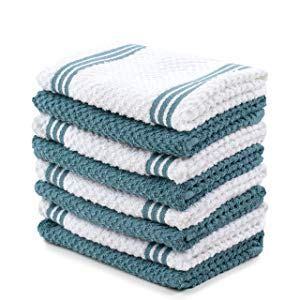 After reading this research, I decided to forgo sponges and now use dish cloths instead. I bought enough so that I can replace the used cloth with a clean cloth every day. Dish cloths are definitely are more economical and eco-friendly option than sponges. Just wash in hot water and dry in your dryer to clean and sanitize. I also recommend replacing your dish drying towel every day. (In case you’re wondering, I use a scrub brush to scrub pots and pans.)
After reading this research, I decided to forgo sponges and now use dish cloths instead. I bought enough so that I can replace the used cloth with a clean cloth every day. Dish cloths are definitely are more economical and eco-friendly option than sponges. Just wash in hot water and dry in your dryer to clean and sanitize. I also recommend replacing your dish drying towel every day. (In case you’re wondering, I use a scrub brush to scrub pots and pans.)
These two common pantry items make cleaning your toilet more fun…
In our traveling home, I can’t clean with bleach because bleach would kill the good bacteria that breaks down solid material in our holding tanks. I recently started using vinegar and baking soda to clean the toilet and oh, what fun it is if you’re a cleaning geek like me! I just pour a cup or so of baking soda in the bowl, then pour in a cup of vinegar. While this combination is hissing and bubbling up, I give the toilet bowl a good scrub and then flush. Job done! I also discovered that the same combination of baking soda and vinegar was all I needed to clean a slow-moving bathroom sink drain. It took a few tries, but then whoosh! The drain was running freely.
How to clear fridge clutter in minutes…
If you’re like many people, you’re storing things in your refrigerator that don’t belong in your refrigerator such as bread and potatoes. I knew about those, but recently learned that I should not be storing fresh peppers or berries in the refrigerator. They actually last longer on the counter! Clear fridge clutter by storing these 30 foods elsewhere. A good rule of thumb is to store foods the way you find them at the store.
How to set the right price for stuff you want to sell…
In my book How to Declutter and Make Money Now, I recommend looking up eBay listings for items that were sold to determine the best listing price, regardless of where you’re planning to sell things. But I just learned about an easier way to price all kinds of items. It’s a used price guide at Statricks.com. A friend of mine mentioned wanting to sell her collection of Waterford crystal bells. I went to the site and sure enough, found listings for all of them. What a fantastic resource! Just remember that a fair price is what buyers are willing to pay and you’re willing to accept.
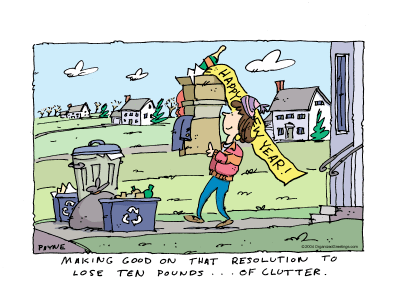 Two ways to reduce stress by making good on your new year resolution.
Two ways to reduce stress by making good on your new year resolution.“Get organized” and “lose weight” are two of the top resolutions people make every new year. I resolved last year to get to my goal weight – 128 in 2018 – and I’m thrilled to report that I left 12 pounds behind in 2018. And I feel so much happier with myself.
Losing excess weight helps can help boost energy and create a more positive self-image. It can also reduce your risk of heart disease, diabetes, cancer, and a variety of other medical problems that can make it difficult to move such as joint issues or back problems – all of which make it harder to declutter your home.
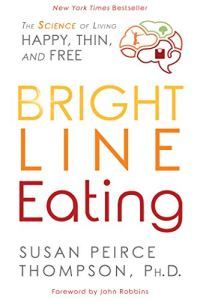 If you want to get rid of excess body clutter, check out the Bright Line Eating program to learn how your brain may be blocking you from losing weight. The book by the same name outlines a simple-to-follow eating program that consists of three meals a day (all real food – no shakes or supplements to buy), portion control, and no foods with sugar or flour. It’s not a fad diet. It’s a way of eating for life. I’ve tried dozens of diets over the years and have to say that Bright Line Eating has been the fastest, easiest and most effective by far. I highly recommend it, especially if you’re addicted to certain foods or have been struggling to lose weight for years.
If you want to get rid of excess body clutter, check out the Bright Line Eating program to learn how your brain may be blocking you from losing weight. The book by the same name outlines a simple-to-follow eating program that consists of three meals a day (all real food – no shakes or supplements to buy), portion control, and no foods with sugar or flour. It’s not a fad diet. It’s a way of eating for life. I’ve tried dozens of diets over the years and have to say that Bright Line Eating has been the fastest, easiest and most effective by far. I highly recommend it, especially if you’re addicted to certain foods or have been struggling to lose weight for years.
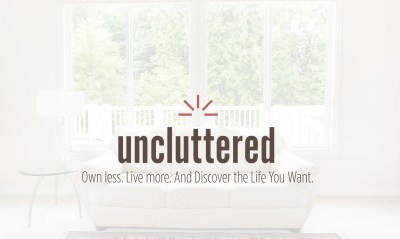 If your resolution is to declutter your home in the new year, you might want to sign up for the newest edition of Joshua Becker’s Uncluttered course that starts in mid-January. I’ve said it before and I’ll say it again…this is the best decluttering course I never created! And, nice guy that he is, Joshua gave me a Friends & Family discount code to share with you – enter FF25 at checkout to save 25% off this 12-week email course that will help you clear the clutter and maintain a clutter-free life in 2019. If you’ve taken the course in the past, remember that you can take it again as often as you wish.
If your resolution is to declutter your home in the new year, you might want to sign up for the newest edition of Joshua Becker’s Uncluttered course that starts in mid-January. I’ve said it before and I’ll say it again…this is the best decluttering course I never created! And, nice guy that he is, Joshua gave me a Friends & Family discount code to share with you – enter FF25 at checkout to save 25% off this 12-week email course that will help you clear the clutter and maintain a clutter-free life in 2019. If you’ve taken the course in the past, remember that you can take it again as often as you wish.
Wishing you a happier, healthier, more clutter-free new year!
The post What I Learned in 2018 About Cleaning and Clutter appeared first on Declutter Your Life with Donna Smallin Kuper.
August 27, 2018
The Best Decluttering Course
I’ve always said that the hardest part of getting organized is getting started. If you’ve been following me for awhile, you know that I recommend that you declutter first because it’s a lot easier to get organized when you have less stuff.
“The first step in crafting the life you want is to get rid of everything you don’t.” – Joshua Becker
Are you familiar with Joshua Becker? He’s the author of The More of Less: Finding the Life Your Want Under Everything Your Own. I met Joshua about two years ago and have been following him ever since.
Joshua is passionate about helping people dig out from under to free up time, energy, and money for living life. To that end, he’s launched what I think is the best decluttering course available. Uncluttered is designed to help you own less, live more, and discover the life you’ve always wanted. It’s been wildly successful – more than 20,000 people have uncluttered their homes with the help of this program.
Own less. Live more. And discover the life you want.
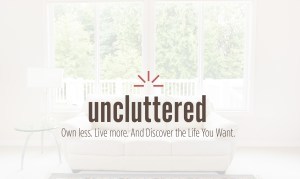 If you’re drawn to the idea of owning less, but need some help getting there, Joshua’s Uncluttered course could be just the ticket, especially if you’ve been trying to declutter on your own without success.
If you’re drawn to the idea of owning less, but need some help getting there, Joshua’s Uncluttered course could be just the ticket, especially if you’ve been trying to declutter on your own without success.
Uncluttered is a 12-week online course with videos, interviews, webinars, articles, weekly challenges, accountability, and community. By the end of this course, you will have decluttered every major living area in your home and begun changing your spending habits. How’s that for a promise?
Here are some of the nice things alumni of the course have said:
“The term life-changing gets thrown around a lot, but this course really is. I went into it with a lot of shame and anxiety. Joshua gently guided us in a way that made lasting change seem possible. My home is much improved, but my mindset is also clearer.” —Kathryn W., Los Angeles, CA
“The power of this shared experience is hard to explain to people, it is so overwhelmingly positive. It not only provides the incentive to keep going, but reminds you there are good people out there. You find yourself rooting for complete strangers. Together, there is a momentum that drives you through the course. It was completely unexpected and so overwhelmingly helpful.” —Tanya S., Webster, NY
If you want a cleaner, happier home, the best time to get started is now.
Uncluttered is offered only three times each year. The fall edition of this course begins officially on Tuesday, September 4, but registration closes on September 2. For more information about the course, click here.
Oh! And I almost forgot – Joshua has given me a friends and family discount to share with you!
Enter the discount code FF25 when you register to get 25% off your registration.
The post The Best Decluttering Course appeared first on Declutter Your Life with Donna Smallin Kuper.
August 22, 2018
Finding Myself in a Mountain of Clutter
 I look at this huge room that’s 30 by 20 feet and see floor-to-ceiling clutter – things with tags on them, never used, nice things. And I ask myself, “Why?”
I look at this huge room that’s 30 by 20 feet and see floor-to-ceiling clutter – things with tags on them, never used, nice things. And I ask myself, “Why?”
How could I buy so many nice things with the best intentions, only to toss them into a pile in the basement? All this stuff I’ve accumulated over the years has no meaning and very little value now. It no longer brings any joy (if it ever did to start with). The wasteful spending and the clutter left in its aftermath are crushing my spirit. Yet the thought of letting go is almost paralyzing.
Answering the question of why
We had necessities growing up, but no luxuries. I was an only child and sheltered. The demands to perform and achieve started at age 5 in ballet, tap, and baton classes. As I grew older, I sang in choir and played the piano in church. I was the first person in my family to graduate from college and go on to be an honors graduate from grad school. This was not my choice, but my parents’ choice that I must get “an education.”
I got my first job at 15 and was thrilled to have it. I attended a parochial school and we all wore uniforms, (no clothing choices) which I loathed. My job at an upscale shoe store gave me the opportunity to start seeing what people from more affluent lifestyles purchased. I saved my paychecks to shop for my own clothes and for things I wanted. Being able to buy just a few things for myself gave me a new sense of freedom. It was a high, like I had never experienced.
A pattern slowly began to evolve over the years, but I never realized or saw it coming. I began to value things, instead of placing any value on myself. I was brought up to honor my mother and father. Why do I not honor myself? The fact that I never learned to value myself crushes my soul.
Looking back, I see a direct correlation between my most “difficult life moments” and my shopping and buying trends. But the joy I felt at the store soon faded away – sometimes in a week or two and sometimes before I ever made it home. At the store, I viewed it as beautiful or necessary. But once I was home with it, the joy was short-lived.
This much I know is true
I think I developed a coping mechanism for the stress, starting at age 5. I was so busy trying to please people, and make others happy, that I lost myself in the process. I placed more value on my stuff than I did on myself.
Clutter is mentally distracting and emotionally draining. Shopping and having more than you need does not bring peace of mind, fulfillment or contentment. It does not give you any more time. It does not make you feel better about yourself. My basement, overflowing and overwhelming, proves the point.
We don’t buy things with our money. We buy things with our precious time. Having more things means having to spend more time taking care of them, keeping them clean, neat, organized and functional – or spend even more time searching for stuff that’s lost in the mountains of clutter. I’m now putting a time value on all purchases, which has really been a game changer for me.
Focusing on myself and my needs is a much better use of my time than shopping. I don’t need or want any more stuff. What I want is to value myself more. That’s the very best gift I can give myself, and it truly is a gift. You can never buy self-worth.
In my journey towards minimalism, I am learning that experiences and memories make me happier than anything I could ever buy. As for the basement, I’ve committed to cleaning it out little by little, one day at a time. And I’m doing it for me.
Reesa-Marie Dawkins teaches statistics for the University of Alaska. She lives near Atlanta, Georgia with her husband Bob. [Editor’s note: Reesa is an active member of my Unclutter.com Organizing Support Group on Facebook. This is a closed group, which means that only members can see member comments and photos. We invite you to join us in the fight against clutter!]
Photo by Christian Chen on Unsplash
The post Finding Myself in a Mountain of Clutter appeared first on Declutter Your Life with Donna Smallin Kuper.
April 19, 2018
Start Your Spring Cleaning with a Weekend Decluttering Challenge
Are you up for a weekend decluttering challenge?
For many of my friends in the north, it’s been a long winter. If you’ve been stuck indoors for the last few months (and even if you haven’t), I’m guessing that clutter has been building in your home. Am I right?
Now that spring has sprung, it’s time to give your home a good spring cleaning. Believe me, it will be worth the time and effort in the long run.
Check out the infographic below from the guys at EZ Living. It lays out the benefits of decluttering your home, provides five methods for getting started, and it also takes you on a room-by-room journey with quick and easy decluttering projects.
As I read through this home declutter guide, I was inspired to create a Weekend Decluttering Challenge for you. This is not one of those 30-day challenges. This is a challenge that you can complete over the weekend and still have plenty of time to rest, relax, and recharge your batteries.
Here’s the challenge: Pick one room to declutter and and complete the three tasks presented in the room-by-room guide for that room. Continue clearing clutter in that room until it meets with your satisfaction. If you have the time and energy, tackle another room! If it takes several weekends to declutter your whole home, so be it!
Are you with me? Joining this challenge will give you some accountability which might just be the incentive you need. Come on. Make the commitment. You’ve got nothing to lose except the clutter!
Report in when you’re done by coming back here and leaving a comment on this post.
Need some support and encouragement to see you through? Join my free organizing support group on Facebook. And if you want some ideas on how to turn clutter into cash, grab a copy of my book How to Declutter and Make Money Now, available in Kindle and paperback formats.
Okay. Now, get to it!
The post Start Your Spring Cleaning with a Weekend Decluttering Challenge appeared first on Declutter Your Life with Donna Smallin Kuper.
November 21, 2017
9 ways to get organized with minimal effort
 If you want a cleaner, happier home, stop wishing you had a magic wand and become the magic wand!
If you want a cleaner, happier home, stop wishing you had a magic wand and become the magic wand!
Here are 9 super-easy things you can do that will have you feeling more organized in no time. Ready? The quicker you get started, the sooner you’ll be done.
Start somewhere, anywhere. I’ve always said that the hardest part of getting organized is started. It really doesn’t matter where you start. Maybe start with the most visible stuff. For example: clear the floor in your bedroom or the countertops in your kitchen. Or start with something small like a purse or junk drawer.
Break large projects into mini-projects. Get organized one drawer, one shelf, one space at a time. Make a point to keep your project small enough to finish in 15-30 minutes max.
Example #1: To declutter your closet, move the clothes you love and wear to one end of the clothes rod. Then, working for just 15 minutes at a time or by the yard on your closet rod, try on each item. If it fits and makes you feel fabulous, hang it back up with other keepers. Once that’s done, go through your shoes and then your purses and accessories. Or tackle the floor and then then the shelves.
Example #2: Go through papers one pile at a time. Flip the pile over and you’ll find the oldest stuff at the bottom, a lot of which may now be outdated and easy to toss/shred. Set a timer for 5-10 minutes and keep going until the timer stops.
Declutter in short bursts. You don’t have to give up your entire weekend to get organized. Look for opportunities to do a little decluttering here and there throughout the day. For example:
When you file a document, do a quick search in the folder for papers that are outdated.
While you’re waiting for a pot of water to boil, straighten up your pantry.
While watching television, take advantage of commercial breaks to sort through a pile of papers, fold laundry, or declutter a drawer that you remove from its cabinet before sitting down.
Take five minutes every night to pick up and put away items that belong elsewhere and generally tidy up. To get into the habit of doing this, do it right after something you always do like brush your teeth.
Stop fighting with your stuff. Does this sound like you? You try to get organized by putting things where you think they should go. And you find yourself repeatedly putting away the same things. Solution: Create a home for those things where they “want” to live.
Example: Set a decorative box or basket on the end or your kitchen counter to be a drop box for the mail and other items such as your cell phone, purse, sunglasses and keys that always end up there.
Get “appy.” Use apps like OfferUp to quickly sell items you no longer love or use. Use an app like Paprika to digitally store and organize your recipes. Look for other ways to minimize paper such as paperless statements for your bank and credit card accounts and apps like Shoeboxed for storing digital images of receipts. (I use the free D-I-Y version.)
Act as if you are organized – and you will become more organized. Do organized people just set things down anywhere? No, they put them away. It only takes a few moments to unload that shopping bag or hang up your coat. The trick is training yourself to do it! But it’s a habit that your future self with thank you for.
Let go of perfect. Done is perfect. You don’t have to have a perfectly organized pantry to reap the benefits of organizing. You also don’t have to find the perfect recipient for every item that leaves your home. Donate everything to one charity and let them do what they do best.
Practice gratitude. Be grateful for all you have – It’s more than enough. Remember that the most important things in life are not things. No amount of things can ever replace the people we love and it’s that love that makes a home a home.
Get free support. Join my free organizing support on Facebook! You can ask questions and get help any time you need it from me as well as other members – people like you who want to live a less cluttered life. It’s a private group so all posts can be seen only by members. We’re in the middle of doing a 30-day decluttering challenge and you’re invited to jump in. At the end of the month, I’ll post the full 30-day challenge if you want to start from the beginning.
Photo by Alia Wilhelm on Unsplash
Full disclosure: Some of the links I post in my blog are “affiliate” links. If you click on an affiliate link, I may receive a small commission for referring you. I only recommend products or services I use personally and/or believe are of value to my readers. All earnings go toward the cost of maintaining and distributing this blog and my quarterly newsletter. Thanks for your support!
(If you wish to receive my quarterly newsletter plus email notifications of new blog posts, sign up HERE.)
The post 9 ways to get organized with minimal effort appeared first on Declutter Your Life with Donna Smallin Kuper.
November 14, 2017
How and where to get rid of trash responsibly
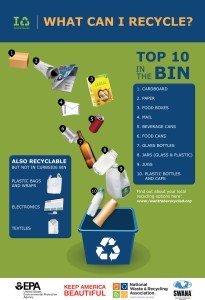 How do you get rid of trash in the most responsible manner? Recycle everything that’s recyclable.
How do you get rid of trash in the most responsible manner? Recycle everything that’s recyclable.
The Environmental Protection Agency (EPA) estimates that 75% of the American waste stream is recyclable, but we’re only recycling about 30% of it. By 2030, the amount of household waste will almost double to 3,000 million tons annually…unless each of us do our part.
The problem isn’t just about maxxing out our landfills. According to the EPA, recycling conserves energy and natural resources. Here are a few examples from a recent report:
Recycling one ton of office paper can save the energy equivalent of consuming 322 gallons of gasoline.
Recycling just one ton of aluminum cans conserves more than 152 million Btu, the equivalent of 1,024 gallons of gasoline.
Reycling just 10 plastic bottles saves enough energy to power a laptop for more than 25 hours.
You probably have curbside recycling bins for things like plastic and glass bottles and jars, aluminum cans, cardboard, newspaper, and food boxes. But what do you do with things that aren’t supposed to go in a curbside recycling bin such as garden hoses, aerosol cans, and propane tanks?
Check out the answers to these Frequently Asked Questions. On this page, you’ll also find links that connect you with local sites where you can correctly dispose of things like household hazardous waste.
Learn more about how to get rid of trash responsibly in this slide show below courtesy of 1-866-JUNK-ITT.com
Of course, the very best thing you can do to reduce waste is to think twice about what you buy so that you have less to get rid of. Here are some ideas for you:
Look for and choose to buy products with minimal packaging or refillable containers.
Bring re-usable bags with you to the supermarket.
Donate used clothing, shoes, furnishings, and household items.
Swap partially used, unwanted hair and beauty products with friends. Do the same with cleaning products.
Re-use items that are re-usable.
Today marks the 20th anniversary of America Recycles Day. What one thing can you do today to demonstrate your commitment to recycling?
This Waste Disposal Guide was provided by 1-866-JUNK-ITT
The post How and where to get rid of trash responsibly appeared first on Declutter Your Life with Donna Smallin Kuper.
How and Where to Get Rid of Trash Responsibly
 How do you get rid of trash in the most responsible manner? Recycle everything that’s recyclable.
How do you get rid of trash in the most responsible manner? Recycle everything that’s recyclable.
The Environmental Protection Agency (EPA) estimates that 75% of the American waste stream is recyclable, but we’re only recycling about 30% of it. By 2030, the amount of household waste will almost double to 3,000 million tons annually…unless each of us do our part.
The problem isn’t just about maxxing out our landfills. According to the EPA, recycling conserves energy and natural resources. Here are a few examples from a recent report:
Recycling one ton of office paper can save the energy equivalent of consuming 322 gallons of gasoline.
Recycling just one ton of aluminum cans conserves more than 152 million Btu, the equivalent of 1,024 gallons of gasoline.
Reycling just 10 plastic bottles saves enough energy to power a laptop for more than 25 hours.
You probably have curbside recycling bins for things like plastic and glass bottles and jars, aluminum cans, cardboard, newspaper, and food boxes. But what do you do with things that aren’t supposed to go in a curbside recycling bin such as garden hoses, aerosol cans, and propane tanks?
Check out the answers to these Frequently Asked Questions. On this page, you’ll also find links that connect you with local sites where you can correctly dispose of things like household hazardous waste.
Learn more about how to get rid of trash responsibly in this slide show below courtesy of 1-866-JUNK-ITT.com
Of course, the very best thing you can do to reduce waste is to think twice about what you buy so that you have less to get rid of. Here are some ideas for you:
Look for and choose to buy products with minimal packaging or refillable containers.
Bring re-usable bags with you to the supermarket.
Donate used clothing, shoes, furnishings, and household items.
Swap partially used, unwanted hair and beauty products with friends. Do the same with cleaning products.
Re-use items that are re-usable.
Today marks the 20th anniversary of America Recycles Day. What one thing can you do today to demonstrate your commitment to recycling?
This Waste Disposal Guide was provided by 1-866-JUNK-ITT
The post How and Where to Get Rid of Trash Responsibly appeared first on Declutter Your Life with Donna Smallin Kuper.
October 25, 2017
Peek inside this pro organizer’s small closet
You think you have a sm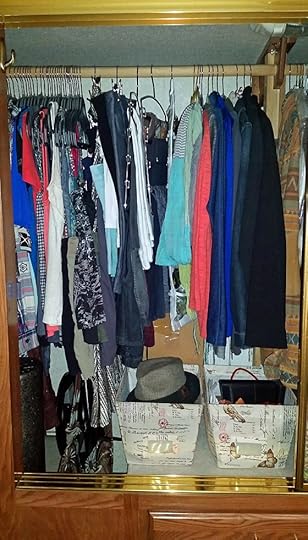 all closet? You should see mine. Here, take a look====>
all closet? You should see mine. Here, take a look====>
My side of the small closet in our tiny home on wheels measures 40 inches wide. I hang most of my clothing, including light jackets, in that 40 inches.
In this post, I’m going to share the closet organizing tips and tools that work in my small closet – and that I recommend for maximizing space in any size closet. Click to enlarge any of the smaller photos for a better view.
Best small closet organizing tips & tools from a pro
When we moved into our motor home, I bought about 50 slim-line swiveling hangers. They take up less space than traditional hangers and their grippy shoulders help to keep clothing in place. Plus, having all the same type of hangers keeps your closet looking tidier.
The reason why I like hangers with swiveling hooks is because no matter how you place an item on the hanger, you can swivel the hook so that the fronts of all items are facing in the same direction when you hang them. Make sense?
And here’s another tip for a neat and organized closet: if you zip and button items that you hang, they are less likely to slip off the hangers and get wrinkled. This has become such a habit for me that I do it after trying on clothes in a store – fitting room attendants love me, I’m sure. Then again, if everyone did that, they might be out of a job!
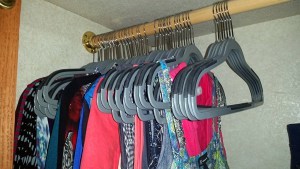 Notice that there are some empty hangers in the middle of my clothes rod. When I remove an item from a hanger, I move the hanger to my “hanger space” so that I can quickly find a hanger when I need one.
Notice that there are some empty hangers in the middle of my clothes rod. When I remove an item from a hanger, I move the hanger to my “hanger space” so that I can quickly find a hanger when I need one.
Speaking of hangers, have you heard about the hanger trick? No one is sure who came up with this idea, but it’s a good one!
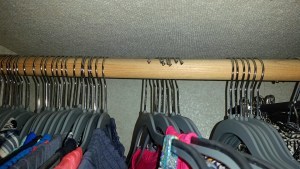 At the beginning of each season, hang everything with the open end of the hanger facing out. When you wear an item and return it to your closet, hang it the usual way with the open end facing the back of the closet. At the end of the season, you can easily tell what you wore and what you didn’t. You know what to do with the ones you didn’t wear!
At the beginning of each season, hang everything with the open end of the hanger facing out. When you wear an item and return it to your closet, hang it the usual way with the open end facing the back of the closet. At the end of the season, you can easily tell what you wore and what you didn’t. You know what to do with the ones you didn’t wear!
I recommend keeping a donation bag in your closet. How many times have you tried on something, took it off because you didn’t like how it looked on you, and then hung it back up? Here’s the thing: There’s a reason why you didn’t wear it – it’s not right for you. Toss it in your donation bag. When the bag gets full, take it to your favorite charity. Or take it to a consignment store and cash in on your clothing clutter!
Since my closet space is limited, I also invested in a set of cascading skirt/short hangers and tiered pants hangers with swing arms. I can (and do) hang two pairs of shorts on each hanger. I have two sets of pants hangers and can hang two pair of pants on each rod if I need to.
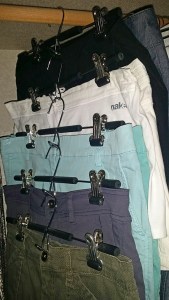
 These space-saving hangers work very well and I highly recommend them for small closets. Many people fold jeans and store them on a shelf or in a drawer. I do have three small drawers for lingerie, sleepwear, and swimwear; three deeper drawers for t-shirts, sweaters, and fleece pullovers; and one larger drawer for my exercise clothing. I prefer to hang everything else.
These space-saving hangers work very well and I highly recommend them for small closets. Many people fold jeans and store them on a shelf or in a drawer. I do have three small drawers for lingerie, sleepwear, and swimwear; three deeper drawers for t-shirts, sweaters, and fleece pullovers; and one larger drawer for my exercise clothing. I prefer to hang everything else.
I hang my favorite scarves on a scarf hanger. I could put them in a bin, but then I would forget that I have them!
As for the two canvas bins you see in the photo below, one holds hats 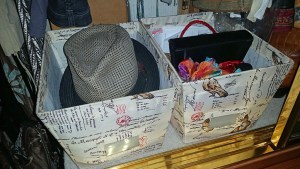 and gloves and the other holds three belts and two small, dressy purses. I was using these bins in our last home.
and gloves and the other holds three belts and two small, dressy purses. I was using these bins in our last home.
Notice that my bins have a slot on the front for labeling. I didn’t label mine because I can look down and see what’s in them. But I do recommend labeling bins when you put them up on a shelf.
(In case you’re wondering what’s behind the canvas bins, I have two boxes with two beautiful pottery vases that have been along for the ride for the last four and a half years! I keep them because they are beautiful pieces that I will display again someday when we decide to move back into a home without wheels.)
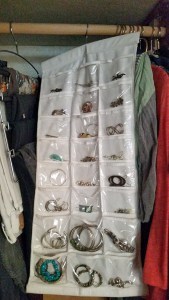 Here’s what I use for storing jewelry – a hanging jewelry organizer with clear pockets on each side. I store necklaces on one side and earrings and bracelets on the other.
Here’s what I use for storing jewelry – a hanging jewelry organizer with clear pockets on each side. I store necklaces on one side and earrings and bracelets on the other.
A really good way to maximize closet space is to add a second hanging rod to double the short hanging space in your closet. My closet is too short to do that. I do have a section that is open all the way to the floor so I hang my dresses on that side. I also use that space to store my keyboard stand, folding piano stool, canvas bag with piano accessories and music, a vacuum cleaner, large foam roller, and large umbrella.
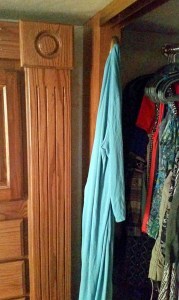 You may also want to add a few hooks on the wall inside or outside your closet or on the back of your closet door so you have a place to hang things like your robe that you will wear again. (The type of hook I recommend can be put up in minutes without nails or screws and can be easily removed at any time without marring the surface.)
You may also want to add a few hooks on the wall inside or outside your closet or on the back of your closet door so you have a place to hang things like your robe that you will wear again. (The type of hook I recommend can be put up in minutes without nails or screws and can be easily removed at any time without marring the surface.)
Or use the space on the back of a door to hang an over-the-door shoe organizer for storing shoes, scarves and belts, or even socks and underwear if drawer space is limited. And if you have a lot of purses, consider a purse organizer.
Do you have a small closet?
One good thing about having a small closet is that it keeps me from overspending on clothing! I also have to be diligent about regularly purging what I no longer love or wear. If I buy something new and don’t have an available hanger, I must choose something that has to go. Almost always, it’s something I haven’t worn in a while, but have been reluctant to let go of.
You know what’s funny? I consider myself a minimalist. But dang. After writing this post and taking these photos today, I realize that I have a lot of clothes. I guess it just goes to show that I’m good at maximizing my small space. And you can be too!
What’s the biggest organizing challenge you have with your closet? Too much stuff? Too little space? What have you found that works really well? Let’s get the conversation rolling below!
The links in this blog post are affiliate links. If you click a link and purchase something, I will get a small percentage of the sale (at no additional cost to you). Please know that I only recommend products or services I use personally and/or believe are of value to my readers.
The post Peek inside this pro organizer’s small closet appeared first on Declutter Your Life with Donna Smallin Kuper.
September 19, 2017
Time to sell your old cell and other stuff – here’s how!
 If you’re like most people, you’ve got stuff you no longer love or use that’s just taking up valuable space in your home, right? What if you could quickly declutter your closets and drawers and make a little extra cash at the same time?
If you’re like most people, you’ve got stuff you no longer love or use that’s just taking up valuable space in your home, right? What if you could quickly declutter your closets and drawers and make a little extra cash at the same time?
Forget about having a yard sale. There are much easier ways to turn clutter into cash – if you know where to look. Here are a few of my favorite online options for selling popular items right now with the least amount of time and effort.
Cell phones and electronic gadgets – Whether you’ve got a drawer full of old cell phones or you’re upgrading to the new iPhone, I recommend getting a quote from a company called Decluttr. They consistently offer top dollar for phones – even more than your cell phone carrier or manufacturer. For example, they’re currently paying up to $455 for iPhones. But it’s not just iPhones they accept. You can also sell your Android, Blackberry, or Windows phone plus iPads, tablets, and gaming consoles. And right now, they’re offering an extra 10% cash for first-time sellers when you use the coupon code FIRST10 (through 09/30/17 at 23:59 EST). They pay for shipping your item to them and you’ll get paid the very next day.
NOTE: For your protection, delete all personal data from your phone before selling. If you don’t know how to do that, the good people at Decluttr will help you.
CDs, DVDs, Video Games – Ding, ding, ding! Decluttr is also my favorite pick for great prices, free insured shipping and next day payments on CDs, DVDs, and video games. Download the free app to quickly scan the bar codes on your items and get a quote. (Sorry, that extra 10% coupon code is for tech items only.)
Books – Decluttr buys books, too! But SellBackYourBook is another one of my favorite book trade-in sites because they also offer good prices, free shipping, and payment within 3 business days. And it’s a very user-friendly site. You can enter up to 20 ISBNs at a time (an ISBN is like a serial number for books). Or, if you have a smartphone, you can use the SellBackYourBook app to scan the ISBNs instead of having to enter all the digits.
NOTE: I once sent a box to another company that was destroyed in shipping and all but one book was lost. When shipping books, use a very sturdy box, plenty of packing material as filler and to protect book edges, and good quality packing tape. Also be sure to insure your package!
Clothing – Cash in on your gently used clothing! All clothing should be freshly cleaned and pressed or steamed if needed and in excellent condition. I have a friend who frequently consigns her clothing to Swap.com. It’s free to ship your items. Swap.com will let you know what items they can accept. Then they will price and list your clothes on their site. When your items sell, you get paid. Swap.com accepts clothing for men, women, and children as well as toys and games for babies and kids. If any of your items are not accepted, you have 14 days to choose if you want to have the items shipped back to you for $5.99, or have them donate the items. Remember that the more current your items, the more likely they are to be accepted and sold.
NOTE: Please read Swap.com’s acceptance policy carefully before sending items as they do charge a fee if 40% or more of the shipment is unacceptable.
Housewares – Replacements Ltd buys china, stoneware, glassware, silver, stainless, and collectibles to resell to customers who are looking for replacements for sets. If you have a popular pattern that is in high demand, you might get a good price here. Keep in mind that you will need to pay to ship items to their facility in North Carolina. Be sure to pack your items carefully and insure your package for current retail value. AntiqueCupboard buys sterling silver flatware and hollowware and pays shipping up to $50.
Gift cards – Okay, gift cards don’t take up a lot of room in your home. But why hold on to a gift card you’re not likely to use? Did you know that you can sell gift cards? I recommend comparing bids from multiple re-sellers at GiftCardGranny. Enter information for the card you want to sell (even if it’s partially used!) and get instant offers from several gift card re-sellers. Choose to receive cash or earn maximum value by trading for another gift card. 
If you’ve got clutter, you’re richer than you think! For more tips on how to cash in on your clutter, check out my book How to Declutter and Make Money Now.
Some of the links in this blog post are affiliate links. If you click on an affiliate link and do business with that company, I will earn a small commission for referring you. Please know that I only recommend products or services I use personally and/or believe are of value to my readers. All earnings go toward the cost of maintaining and distributing this free subscription blog. Thanks for your support!
Photo by Ewan Robertson on Unsplash
The post Time to sell your old cell and other stuff – here’s how! appeared first on Declutter Your Life with Donna Smallin Kuper.
July 31, 2017
Why home cleaning should include cleaning indoor air

Photo by SHTTEFAN on Unsplash
You know that a germ-y kitchen counter is unhealthy, but how healthy is the air you breathe? Home cleaning should include cleaning indoor air.
The U.S. Environmental Protection Agency (EPA) estimates that indoor air pollutant levels may be two to five times as high as the pollutant levels outdoors. Indoor air pollutants include tobacco smoke, vapors from household products and building materials, various biological pollutants, carbon monoxide, and radon. These contaminants can be harmful to your health, even fatal in high concentrations.
Clean dust and biological pollutants
Normal levels of dust in a home do not generally cause health problems. But high levels can result in allergic reactions ranging from nasal congestion to asthma. That’s because house dust contains a whole slew of biological air pollutants, including viruses, bacteria, molds, mildew, pollen grains, pet dander, and dust mites.
In addition to keeping dust and other particulates in check with regular vacuuming, it’s also important to monitor and control the level of moisture in your home. High relative humidity and damp surfaces encourage the growth of molds. Too much moisture in the air also creates a fertile breeding ground for dust mites.
The best way to control humidity is with proper ventilation and dehumidifiers. Your goal should be to keep the relative humidity under 60 percent, and ideally between 30 and 50 percent. Externally vented exhaust fans in bathrooms, kitchens, and laundry rooms can go a long way toward controlling moisture levels.
Beware of household products that pollute indoor air
Many common household products contain solvents and chemicals that emit potentially harmful gases during use – and even in storage. So don’t store opened containers of paints, varnishes, and similar materials inside your home. Buy these products in limited quantities for use as needed.
Avoid the use of aerosol products in your home. Also, remove dry-cleaned items from their bags and allow them to air (outdoors if possible) before wearing or storing them to reduce your exposure to perchloroethylene.
Building materials and furnishings are another major source of organic air pollutants. Formaldehyde, for example, is used in mattress ticking and to add permanent-press qualities to clothing and draperies. Formaldehyde is also widely used in the manufacture of pressed-wood products used in paneling, flooring, cabinetry, and furniture. So when choosing home furnishings and building materials, opt for natural materials such as wood and stone that are not manufactured with the use of adhesives.
Test for deadly gases
Each year, nearly 300 people in the United States die from carbon monoxide poisoning. Even more die from carbon monoxide produced by idling cars in the garage. The most important thing you can do to prevent carbon monoxide poisoning is to properly use and maintain fuel-burning appliances. A carbon monoxide detector should be used only as a backup. Research the best detectors through Consumer Reports, the American Gas Association, and Underwriters Laboratories (UL). For the most reliable protection, do not buy a detector without UL certification.
As with carbon monoxide, you can’t see, taste, or smell radon. But once radon is in your home, the trapped gas decays into radioactive particles that can be trapped in your lungs when you breathe. Nearly one in 15 homes in the United States has a high level of indoor radon.
Radon exposure is the leading cause of lung cancer in non-smokers and those with asthma are more susceptible. According to the American Lung Association, radon inhalation accounts for around 21,000 deaths per year in the U.S. – six times the number of deaths attributed annually to house fires and carbon monoxide poisoning.
Sometimes radon enters a home through well water, but most often is seeps up through the ground and into your home through cracks in the foundation, floor, or walls or around service pipes. The U.S. Surgeon General and the EPA recommend that all homes be tested for radon.
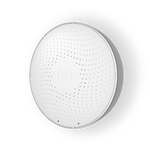 The most common type of radon test kit used today is based on charcoal canisters, which only provide a short-term measurement (days) and require being sent to a lab for analysis. But radon levels fluctuate significantly from day to day, month to month, and year to year. The best way to test is to continually monitor radon levels with a system like Airthings Wave that includes an easy-to-mount, battery-powered home sensor device and a free mobile app. When Wave detects high radon levels for a period exceeding national guidelines (48 hours in the United States), you will be notified via the phone app and given recommendations for how to reduce radon levels.
The most common type of radon test kit used today is based on charcoal canisters, which only provide a short-term measurement (days) and require being sent to a lab for analysis. But radon levels fluctuate significantly from day to day, month to month, and year to year. The best way to test is to continually monitor radon levels with a system like Airthings Wave that includes an easy-to-mount, battery-powered home sensor device and a free mobile app. When Wave detects high radon levels for a period exceeding national guidelines (48 hours in the United States), you will be notified via the phone app and given recommendations for how to reduce radon levels.
How to freshen indoor air
The two most effective strategies for improving air quality are to control the sources of specific pollutants and to improve ventilation. For best quality, the air in your home should be continually exchanged with fresh air. It’s particularly important to ensure good ventilation when using spray disinfectants, cleaners, and repellents. If you can’t open windows, use ceiling and exhaust fans to facilitate the exchange of fresh air.
Air cleaners may be useful as a secondary means of removing contaminants. When buying an air cleaner, look for the clean air delivery rate (CADR) certification seal. This seal indicates that the air cleaner has been tested by an independent testing agency, and it tells you how well the air cleaner reduces pollutants. As well as the size of the room it is suitable for. The higher the CADR number, the faster the unit filters air.
Don’t confuse air purifiers with air cleaners. An air purifier only purifies what’s in the air. An air cleaner uses a filter to capture allergens that tend to float, such as dust and pet dander.
The post Why home cleaning should include cleaning indoor air appeared first on Declutter Your Life with Donna Smallin Kuper.
The One-Minute Organizer Blog
- Donna Smallin Kuper's profile
- 45 followers




